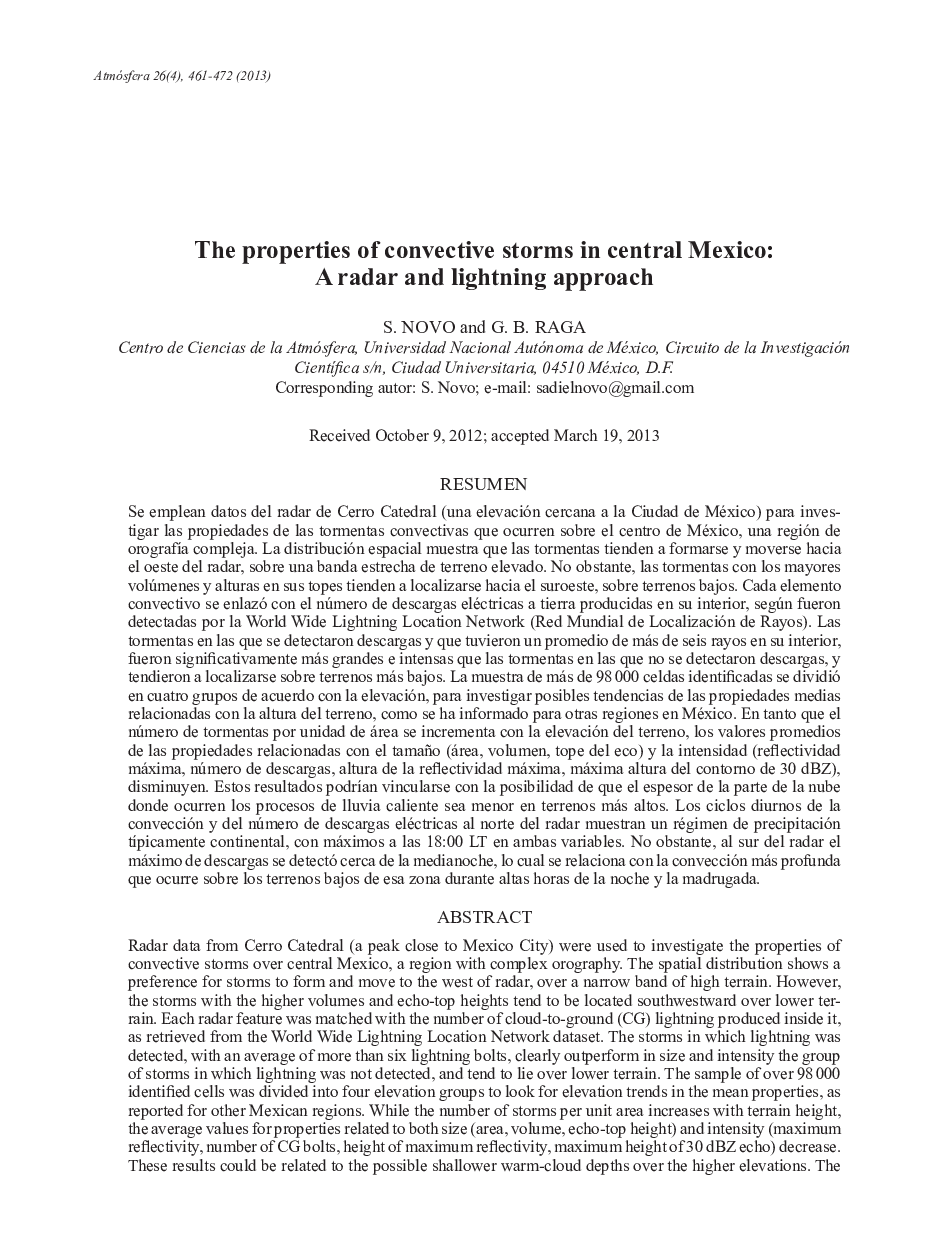| کد مقاله | کد نشریه | سال انتشار | مقاله انگلیسی | نسخه تمام متن |
|---|---|---|---|---|
| 4462040 | 1313457 | 2013 | 12 صفحه PDF | دانلود رایگان |

ResumenSe emplean datos del radar de Cerro Catedral (una elevación cercana a la Ciudad de México) para investigar las propiedades de las tormentas convectivas que ocurren sobre el centro de México, una región de orografía compleja. La distribución espacial muestra que las tormentas tienden a formarse y moverse hacia el oeste del radar, sobre una banda estrecha de terreno elevado. No obstante, las tormentas con los mayores volúmenes y alturas en sus topes tienden a localizarse hacia el suroeste, sobre terrenos bajos. Cada elemento convectivo se enlazó con el número de descargas eléctricas a tierra producidas en su interior, según fueron detectadas por la World Wide Lightning Location Network (Red Mundial de Localización de Rayos). Las tormentas en las que se detectaron descargas y que tuvieron un promedio de más de seis rayos en su interior, fueron significativamente más grandes e intensas que las tormentas en las que no se detectaron descargas, y tendieron a localizarse sobre terrenos más bajos. La muestra de más de 98 000 celdas identificadas se dividió en cuatro grupos de acuerdo con la elevación, para investigar posibles tendencias de las propiedades medias relacionadas con la altura del terreno, como se ha informado para otras regiones en México. En tanto que el número de tormentas por unidad de área se incrementa con la elevación del terreno, los valores promedios de las propiedades relacionadas con el tamaño (área, volumen, tope del eco) y la intensidad (reflectividad máxima, número de descargas, altura de la reflectividad máxima, máxima altura del contorno de 30 dBZ), disminuyen. Estos resultados podrían vincularse con la posibilidad de que el espesor de la parte de la nube donde ocurren los procesos de lluvia caliente sea menor en terrenos más altos. Los ciclos diurnos de la convección y del número de descargas eléctricas al norte del radar muestran un régimen de precipitación típicamente continental, con máximos a las 18:00 LT en ambas variables. No obstante, al sur del radar el máximo de descargas se detectó cerca de la medianoche, lo cual se relaciona con la convección más profunda que ocurre sobre los terrenos bajos de esa zona durante altas horas de la noche y la madrugada.
Radar data from Cerro Catedral (a peak close to Mexico City) were used to investigate the properties of convective storms over central Mexico, a region with complex orography. The spatial distribution shows a preference for storms to form and move to the west of radar, over a narrow band of high terrain. However, the storms with the higher volumes and echo-top heights tend to be located southwestward over lower terrain. Each radar feature was matched with the number of cloud-to-ground (CG) lightning produced inside it, as retrieved from the World Wide Lightning Location Network dataset. The storms in which lightning was detected, with an average of more than six lightning bolts, clearly outperform in size and intensity the group of storms in which lightning was not detected, and tend to lie over lower terrain. The sample of over 98 000 identified cells was divided into four elevation groups to look for elevation trends in the mean properties, as reported for other Mexican regions. While the number of storms per unit area increases with terrain height, the average values for properties related to both size (area, volume, echo-top height) and intensity (maximum reflectivity, number of CG bolts, height of maximum reflectivity, maximum height of 30 dBZ echo) decrease. These results could be related to the possible shallower warm-cloud depths over the higher elevations. The diurnal cycles of convection and lightning north of the radar show a nearly typical continental regime of precipitation in that zone, with maxima at 18:00 LT in both variables. However, south of the radar, a maximum in lightning activity occurs during late night and early morning, which is linked with the deeper nocturnal convection over the lower terrain in that zone.
Journal: Atmósfera - Volume 26, Issue 4, October 2013, Pages 461–472